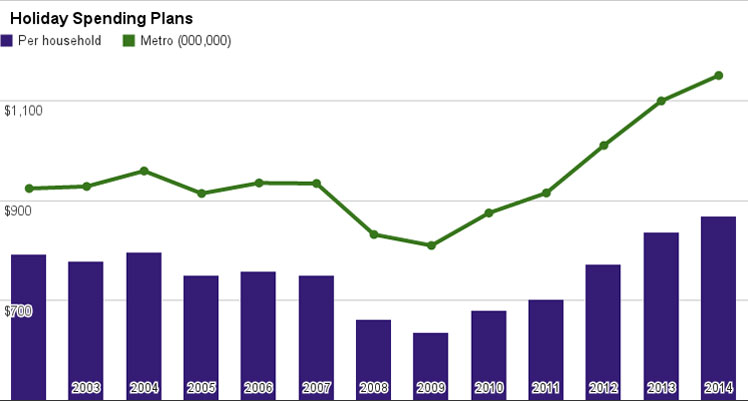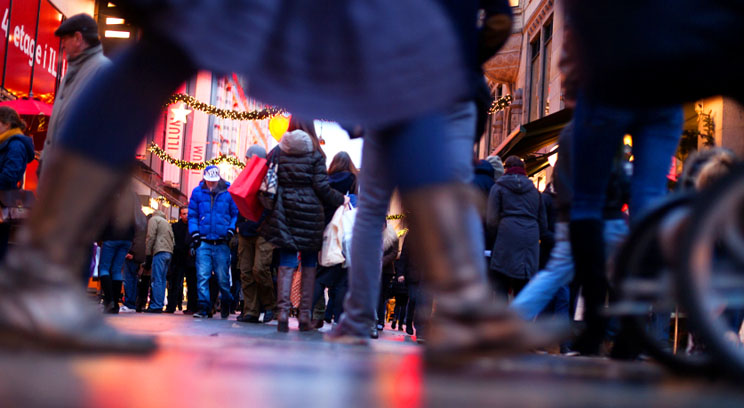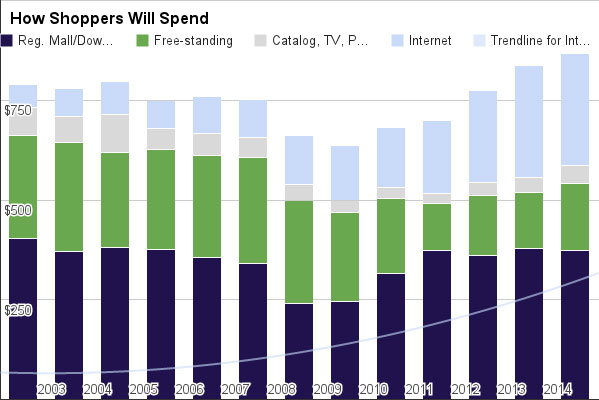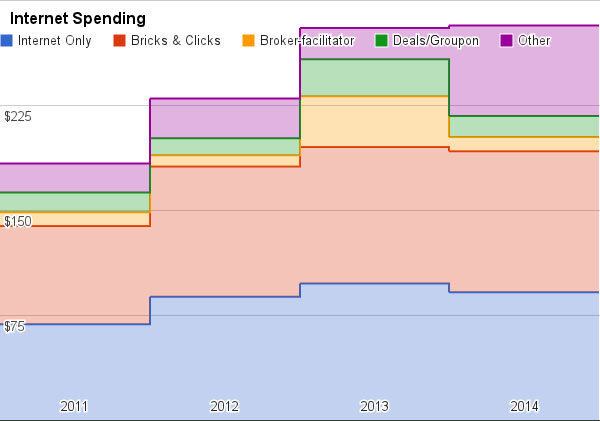The spirit of holiday giving is alive and well in the Twin Cities, according to research conducted by marketing professors at the University of St. Thomas.
Metro region shoppers are planning to spend $868 per household this holiday season. That’s the highest amount since the St. Thomas Holiday Sentiment Survey began 13 years ago. It’s up $31 or 3.7 percent from 2013 and up $231 or 36 percent from the survey’s recession-era low point in 2009.
When it comes to gift giving, Twin Cities shoppers are significantly more optimistic this year than they were five years ago. When asked if they’d spend more or less on holiday spending, 24 percent said they’d spend less and 17 percent said they’d spend more. That compares to 2009, when 54 percent said they’d spend less and 8 percent said more. Fifty-nine percent this year said they’d spend about the same, while in 2009 39 percent said they’d spend the same.
The annual survey is conducted in late October and early November and provides data on Twin Cities holiday shopping trends. The survey measures the intent of Twin Cities shoppers: how much they think they will spend for holiday gifts, what they will spend it on, and where they will spend it.
The research is conducted by Dr. Dave Brennan, Dr. Lorman Lundsten, Dr. Sandra Rathod and Jonathan Seltzer at St. Thomas’ Opus College of Business.
Generally tracking the path of the recession, the survey’s decline in predicted spending first appeared in 2008 and was especially pronounced from 2008 to 2010. There have been steady, incremental gains in predicted holiday spending per household since the 2009 lowpoint of $637.
From 2002 to 2009, the St. Thomas study mirrored or painted a slightly more pessimistic holiday shopping picture than national surveys. From 2010 to 2013, St. Thomas’ data was more optimistic. This year, the university’s predicted increase in household spending of 3.7 percent is slightly lower than national predictions: Deloitte & Touche is predicting a 4 to 4.5 percent increase, the National Retail Federation is predicting 4.1 percent, and the International Council of Shopping Centers is predicting 4 percent.
Based on survey responses and the population of the greater Minneapolis-St. Paul metro area, the researchers predict that metro-region shoppers will cumulatively spend $1.15 billion this year, up 4.6 percent from last year’s predicted $1.09 billion. Like the per-household survey prediction, this year’s metrowide prediction is the highest in the 13 years of the survey. And it is up 42 percent, or $340 million, from the cumulative spend predicted back in the gloomy days of 2009.
It might have something to do with the nice weather Twin Citians enjoyed this fall, but respondents said they had completed 18.5 percent of their holiday shopping by Nov. 1. That’s down from 21.4 percent last year.
The St. Thomas professors who conducted the study emphasize that actual spending might be different because shoppers could spend more or less than they planned once they get into the stores or online.

A peek under the tree
What will Twin Cities shoppers buy with their $868? The professors created an index to analyze the relative popularity of 14 gift categories. It sheds light on the “what’s hot” question and allows year-to-year comparisons.
The list did not change significantly this year, with shoppers again picking perennial frontrunners: gift certificates, clothing and cash. Categories that moved up the most were computers, cell phones and travel; categories that moved down the most were video games, books and jewelry.
The categories, listed with most popular at the top:
1. Gift certificates (last year 1)
2. Clothing/accessories (last year 2)
3. Cash (last year 3)
4. Travel (last year 6)
5. Toys/hobbies (last year 5)
6. Computers/related items (last year 9)
7. Books (last year 4)
8. Entertainment (last year 7)
9. Sporting goods (last year 10)
10. Cell phones, related items (last year 13)
11. Consumer electronics (last year 11)
12. Video games (last year 8)
13. Furniture/furnishings (last year 14)
14. Jewelry (last year 12)
Where they spend
For the past 13 years the survey has asked shoppers where they plan to spend their money. This year's results show that shopping malls remain popular but over the years have lost some ground to free-standing stores and especially the Internet.
Respondents plan to spend 43 percent of their holiday budget at the region’s malls and downtown areas. That’s down from 45 percent last year. Shoppers will spend 19 percent at free-standing stores this year, up from last year’s 17 percent.
After 12 years of steady increases, the Internet showed a very small decline this year. Last year 34 percent of the household holiday budget was spent on the Internet and this year it’s 33 percent.
Catalogs, meanwhile, will account for 5 percent of this year’s shopping dollar. That’s up a percent from last year.
To find out what kind of Internet sites are most popular with shoppers, researchers asked respondents to indicate what portion of their Internet spending would be done on four kinds of online sites:
- “Bricks and clicks” sites, operated by stores such as Target, received 36 percent.
- “Internet only” sites, such as Amazon, received 33 percent.
- “Deals” sites, such as Groupon, received 5 percent.
- “Broker-facilitator” sites, such as eBay, received 4 percent.
Again this year, respondents were asked to list two stores and two websites where they planned to shop.
In the store category the five most popular, in order, were Target, Macy’s, Kohl’s, JC Penney and Best Buy.
In the online category, for the second year Amazon was mentioned nearly six times more often than second-place Target. Rounding out the top five were eBay, Groupon and Best Buy.
Most-popular malls and shopping areas
Which of the 16 enclosed malls, outdoor shopping centers and downtowns are going to attract the most shoppers?
The researchers approached that question from two perspectives: first, which mall in the region are consumers planning to visit at least once for holiday shopping; second, which mall are they planning to shop at most for the holidays. The results are not the same.
When asked which malls or downtowns they planned to visit at least once for their holiday shopping, survey respondents listed, from most-popular to least-popular (note that there were some ties last year):
1. Mall of America (last year 1)
2. Rosedale (last year 2)
3. Southdale (last year 3)
4. Eden Prairie (last year 6)
5. Ridgedale (last year tie for 7)
6. Burnsville (last year 4)
7. Premium Outlets of Eagan (last year not listed)
8. Woodbury Lakes area (last year tie for 7)
9. Arbor Lakes area (last year tie for 8)
10. Maplewood (last year 5)
11. Northtown (last year 9)
12. Downtown Minneapolis (last year tie for 10)
13. Galleria (last year not listed)
14. Albertville Outlet Center (last year 10)
15. Riverdale Area (last year tie for 8)
16. Downtown St. Paul (last year 11)
The Mall of America, Rosedale and Southdale have held these one-two-three rankings for the past five years, as well as 13 years ago when the survey began. The Mall of America has been the top, shop-at-least-once-for-the-holidays mall for all 13 years with the exception of 2004-2006 when Rosedale was No. 1.
When asked where they planned to do most of their holiday shopping this year, respondents listed, in order (note that there is one tie this year):
1. Rosedale (last year 2)
2. Mall of America (last year 1)
3. Ridgedale (last year 7)
4. Eden Prairie (last year 8)
5. Maplewood (last year 4)
6. Riverdale area (last year 9)
7. Southdale (tie for 7) (last year 6)
7. Burnsville (tie for 7) (last year 5)
8. Woodbury Lakes area (last year 3)
9. Arbor Lakes area (last year 10)
10. Northtown (last year 12)
11. Downtown Minneapolis (last year 12)
12. Albertville Outlet Center (last year 13)
13. Galleria (not listed last year)
14. Premium Outlets of Eagan (not listed last year)
15. Downtown St. Paul (last year 13)
This is the 10th time in the 13 years of the survey that Rosedale finished No. 1 in the most-shopped list. The Mall of America has held it three times, including last year.
What the research tells us
“Our data tell us that consumers are ready to buy,” Brennan said. “The unemployment rate in the Twin Cities is a relatively low 3.6 percent, and while wages have not rebounded from the recession the way the job market has, I think people are adjusting and they feel the economy is stable. The percentage of respondents who told us they planned to spend more this year, at 17 percent, is the second highest in the 13 years we’ve conducted the survey. At the same time, the percent who said they are going to spend less, at 24 percent, is the second lowest we’ve seen.
“Coming out of the recession we saw larger annual percentage increases in household holiday spending … 8 percent last year compared to 4 percent this year … but it is harder to maintain those large increases when you already are doing well,” he added.
“I think we’ll see a heavy promotional year for holiday sales,” Lundsten said. “But the retailers are being more careful than in the past when it comes to inventories. The great bargain year was 2007 when they expected a boom year but it went bust. That was the year you could get 40 and 50 percent discounts.”
He predicted that sales will be on selected items before Thanksgiving, but after turkey day expect to see broader, more storewide discounting.
The professors note that the retailers are creating more shopping events, and taking advantage of them. They include Thanksgiving on Nov. 27, Black Friday on Nov. 28, Small Business Saturday on Nov. 29 and Cyber Monday on Dec. 1.
“Many of the stores had their holiday displays up before Halloween,” Seltzer said, “but they didn’t advertise holiday-related products until the weekend after Halloween, and then the Sunday papers and television were bursting Christmas advertising.”
The professors are watching the growing phenomenon of stores opening at ever-earlier times on Thanksgiving. “What we sometimes call ‘Christmas Creep’ began when stores started opening earlier and earlier on Black Friday, until they opened at midnight,” Seltzer said. “Then they started opening Thanksgiving evening. This year several will be opening at 5 p.m. We are also seeing ‘Black Friday Creep’ with some Black Friday promotions available the Wednesday and weekend before Thanksgiving.
“I don’t think you’ll see store openings move up to noon on Thanksgiving,” he predicted. “Most families have their big meals around midday, so noon would be too early to open a store. However, once the meal is over, they say, ‘What should we do now?’ And of course many want to go shopping; for some it’s becoming a family tradition.”
At least three large stores in the metro area are just saying no to Thanksgiving sales; they are Nordstrom, Costco and Home Depot.
Will the data-breach problems affect credit-card use this shopping season? “We don’t think so,” Lundsten said. “We hear on the news more and more often about the theft of credit-card data, so we are getting used to it. Also, not many of us have been directly affected, or know someone who has had problems with their cards or lost any money. We don’t see what you might call a ‘cash Christmas’ in the stores, and consumers will continue to use their cards on the Internet.’”
The professors also are keeping tabs on the progress of outdoor shopping areas that sometimes are called lifestyle shopping centers. While not all identical, they don’t have large department stores as anchors, like most regional malls, and recreate the look and feel of an old-fashioned main street. Pedestrian-friendly, they can be located in a smaller space and in areas that might not support a regional mall.
This year the professors added to their survey list a recently opened shopping center, the Premium Outlets of Eagan, as well as the Galleria, an Edina shopping area that first opened in the 1970s.
“In our survey, the Premium Outlets of Eagan was ranked seventh of 17 shopping areas when we asked where shoppers planned to visit at least once for the holidays, while the Galleria placed 13th,” Rathod said. “However, when we asked where shoppers planned to do most of their holiday shopping, Premium Outlets joined the Galleria near the bottom of the list. I think part of the reason is the newness of Premium Outlets and people will want to see it, and it also is seen as being more upscale than many of the shopping areas in the Twin Cities.”
“The importance of the dales, or the big malls, is diminishing,” Brennan said. “When we began our survey in 2002, they attracted 51 percent of the holiday spending dollar. Little by little, that percentage dropped to 36 percent by 2008. There was a rebound to 53 percent in 2011, but they have again dropped to 43 percent.
“There are so many more places to shop now,” he said. “There are the smaller lifestyle shopping centers, and of course the Internet, which now attracts a third of all the shopping dollars spent by Twin Cities residents.
“Still, it always is interesting to watch the battle for the top spot between the two giants of Twin Cities shopping, Rosedale and the Mall of America,” Brennan added. “They always come in at number one or number two, depending on whether shoppers will visit there at least once, or if they plan to do most of their shopping there.”
That kind of head-to-head competition doesn’t exist on the Internet, with Amazon leading the pack by a huge margin.
“Amazon is a wild card that we’re watching closely,” Seltzer said. “They lost almost half a billion dollars in the third quarter and the company has indicated the losses may increase in the fourth quarter. They have been buying sales at the expense of profit and it will be interesting to see how aggressive they will be this holiday season.”
While the days of the “must-have” Christmas toy seem to be behind us, Seltzer says possible candidates this year are two dolls, Anna and Elsa, who are characters in the popular Disney movie “Frozen.”
The St. Thomas professors agree that holiday shoppers in the Twin Cities, like the rest of the nation, will get a boost from gasoline prices that have fallen below $3 per gallon for the first time since 2010.
The researchers
Brennan, Lundsten, Rathold and Seltzer are members of the Opus College of Business faculty.
Brennan, who holds his Ph.D. from Kent State University, is a professor of marketing and co-director of the university’s Institute for Retailing Excellence.
Lundsten is a professor emeritus of marketing who taught retailing and marketing research. He holds a doctorate from the University of Michigan.
Rathod, whose Ph.D. is from Purdue University, is the Opus College of Business Distinguished Service Professor. She teaches marketing strategy, consumer behavior, communication research and applied business research.
Seltzer teaches international marketing and distribution channels. A former vice president of industry and government relations at Supervalu Inc., he holds an M.B.A. from the University of Chicago.
The Institute for Retailing Excellence, part of the Opus College of Business, conducts research and offers educational programs for those who work in retailing.
Survey method
This year’s holiday spending survey included 306 online responses from households in the 13-county Minneapolis-St. Paul Metropolitan Statistical Area, which includes two counties in western Wisconsin. The respondents reflect the demographics of the area as well as those who responded to previous holiday spending surveys.









